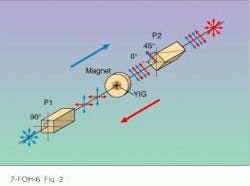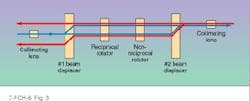Optical isolators direct light the right way
GERALD E. LANO and CHRISTOPHER PINYAN
The performance and lifetime of lasers can be degraded by backreflections into the laser cavity. An optical isolator, commonly described as a "one-way valve" for light, is passive, nonreciprocal device that can eliminate such deleterious feedback effects. A signal beam is allowed to propagate almost unimpeded in the forward direction, whereas light returning from downstream is prohibited from reaching the cavity. The heart of an isolator is based upon a magneto-optic rotator that uses the Faraday effect to manipulate the polarization plane of the propagating light.
Optical isolators yield more reliable performance from the laser in use, including longer lifetime, increased frequency stability, side-mode suppression, more ideal power versus current curves, and steadier power output. Isolators can also protect one laser from others in the system, as in an erbium-doped fiber amplifier (EDFA), in which the source laser must be shielded from the pump laser and vice versa.
The devices are valuable additions to laser research, communications, and instrumentation applications such as analog transmission systems, soliton transmission systems, erbium-doped fiber amplifiers, and fiberoptic sensors and test equipment. Free-space isolators are used directly in laser packages, inside diode-pumped solid state lasers, and position-sensing equipment.
Magneto-optical rotation
The Faraday effect is the rotation of polarization as light passes through a crystal in a magnetic field. A rotation of 45° is the design target for a typical system. Various factors contribute to the amount of polarization rotation the light experiences; the principal ones are the Verdet constant, which depends on magneto-optic properties of the crystal, and specific rotation. The amount of rotation for some crystals depends on the integral of the magnetic field parallel to the propagation axis of the light over the length of the crystal. These crystals use a Verdet constant with units in degrees of rotation per oersted millimeter. Other crystals generate a rotation that is linear with the length of the crystal once a certain field, termed "saturating field," is reached. This type of crystal uses a specific rotation with units of degrees of rotation per millimeter.
Other factors influencing the degree of rotation are crystal temperature and operational wavelength. For most rotators, increasing the temperature will decrease the amount of rotation. Similarly, the longer the source wavelength, the lower the Verdet constant or specific rotation. These reductions may be overcome by increasing the length of the crystal, increasing the magnetic field, or selecting a different rotator material altogether.
For the visible spectral region (500-1064 nm), the most common rotator is terbium gallium garnet. Terbium-doped glasses are also used. New crystals such as cadmium manganese telluride (CMT) and mercury-doped CMT also have been developed. These crystals drastically reduce the magnetic fields required and therefore allow much smaller packages. They do have higher losses than the more conventional materials, but researchers are working to improve their performance.
Communications applications at 1.3 and 1.5 µm use saturating rotators. This group includes bulk-crystal yttrium iron garnet (YIG) and a broad range of epitaxially grown crystals based on YIG. Examples of dopants include holmium, terbium, ytterbium, and gallium (see Fig. 1).
Free-space isolators
Isolators are typically divided into two categories: free-space and fibered isolators. Free-space isolators are used with beams propagating in open air, or free space. They are generally classified as large or small devices. Large devices feature nonsaturating rotators. A typical device is 2 in. in diameter and 4 in. long, with an aperture of an inch or more, incorporated in a laboratory Nd:YAG laser system. Small devices, such as a 3-mm-diameter, 1.9-mm-long isolator for diode-laser applications, are based on saturating rotators. The components in these devices are often tilted in the package, or the entire isolator is tilted during installation. Otherwise, the isolator itself could cause the very reflections it is supposed to guard against.
A typical free-space isolator consists of two polarizers placed on either side of a Faraday rotator (FR). The polarization planes of the polarizers are oriented at 45° with respect to each other. In forward operation, the input beam passes through the first polarizer and into the FR, where the polarization is rotated 45°, allowing the beam to pass through the output polarizer unimpeded. In reverse operation, light passes through the output polarizer, then into the FR.
Faraday rotators are nonreciprocal devices. In other words, the direction of polarization rotation with respect to an absolute frame of reference is not reversed when the beam passes through the FR in the return direction. The polarization of the beam passing out of the FR is rotated 90° with respect to the input polarizer, which then blocks the return beam from re-entering the laser cavity. The beam may be absorbed in the polarizer or rejected for monitoring via an escape port (see Fig. 2).
Compact free-space isolators form the largest portion of the isolator market. These tiny devices are put into semiconductor-laser packages between the output fiber and the laser chip (see photo at top of this page). An optical element such as a gradient-index, aspheric, or ball lens couples the light from the diode laser through the isolator and into the fiber. Apertures typically vary from 1 to 1.5 mm. The design goal is to achieve the largest clear aperture in the most compact possible device. Some isolators are now manufactured with the coupling lens incorporated in the housing, reducing the number of components the laser manufacturer must handle in the packaging process.
Fibered isolators
Fibered isolators, typically more complicated, are designed to go directly into a fiber system. They are installed via splicing or connectors. This category of isolator is also divided into two classifications. The first group is polarization-sensitive, consisting of free-space isolators with fibers attached. Power loss through the device depends greatly (>40 dB) on the polarization state of the light in the input fiber and may be overcome using polarization-maintaining fiber. The second type uses spatial or angular separation of the light to create the isolation required. This type was created to be polarization insensitive. The power loss through the device is only marginally dependent (typically <0.2 dB) on the input polarization state.
Polarization-sensitive devices are built in a variety of configurations. The standard version consists of the isolator flanked by two fibers and two collimating lenses. If the input fiber is removed, the device becomes a fiber with an integrated isolator, suitable for coupling output from a diode laser. Removal of the input lens allows a collimated beam to be launched through the isolator and coupled to the fiber. Conversely, if the output fiber and lens are removed, the device is now an isolated collimator.
The polarization-insensitive devices are a bit more complex. Incoming light is collimated by a lens and split into two polarization states by a birefringent crystal. The two beams pass through a FR and are recombined by a second crystal. In the reverse direction, the beams are separated by the output crystal and go through the FR. Because of the polarization rotation induced by the rotator, the input crystal further separates the beams. Isolation is achieved by either spatial or angular separation of the two beams, preventing them from entering the input fiber (see Fig. 3).
Performance characteristics
The most important performance characteristics of these devices are isolation and insertion loss. Isolation is a measure of how well the device isolates the laser cavity from the return beam, defined as the ratio of the incident power to transmitted power in the reverse direction. Insertion loss, or transmission, is the ratio of incident light to transmitted light in the forward direction. All characteristics may vary with changes in device temperature and/or source wavelength. Devices are typically designed for the center of the temperature and wavelength ranges in which they will be used.
Free-space isolators, because they are used with beams going through the air to interact with other components, have additional mechanical restrictions. In addition to physical dimensions, optical axis height, and clear aperture, these include beam offset or displacement, and deviation. Multipass devices, while compact, sometimes introduce significant beam offsets, limiting their usefulness in certain situations.
Fibered devices have design parameters of their own, and the list seems to keep growing. Polarization-dependent loss is probably the most important of these, followed by return loss or backreflection, polarization-mode dispersion, and higher-order effects such as composite second-order distortion (CSO) and composite triple beat (CTB). Return loss is the ratio of the optical power reflected back to the laser cavity to the power incident on the isolator; an isolator is useless if it creates its own backreflection. Polarization-mode dispersion is the delay between the two polarization states passing through the device. Because they follow different optical paths through the device, time of flight may be different. CSO and CTB are more complex effects that are not discussed here.
Packaging concerns
Environmental concerns play a major role in isolator design for both free-space and fibered devices. Epoxies have been the standard bonding method for high-reliability devices, but the current trend is toward metal bonding via soldering, laser soldering, or laser welding. The aim is to create a hermetically sealed device that will stand up to rigorous environmental testing, including mechanical shock and vibration, temperature cycling with and without controlled humidity, and long-term high- and low-temperature storage. All of this may seem like overkill until one considers the expense of changing a repeater on the ocean floor.
The isolator is a vital element of the optical-system designer`s arsenal. When faced with the ever increasing demands of the modern fiberoptic communication industry, the isolator has evolved in performance, packaging, and price. To stay ahead in a competitive market, designers have begun adding additional features to conventional isolators to make them more versatile, including additional ports, dual-wavelength capability, or wavelength-division multiplexing capability. To keep pace with related technologies, optical isolators will continue to shrink, do more, and last longer for a lower price.
Gerald E. Lano is vice president of marketing and Christopher Pinyan is product manager at Isowave, 64 Harding Ave., Dover, NJ 07801.



